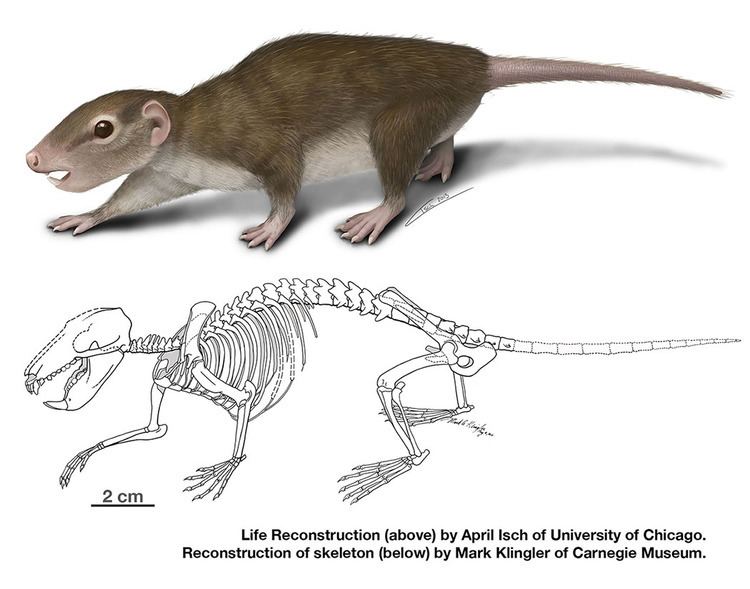Rank Genus | Phylum Chordata | |
 | ||
Similar Multituberculata, Megaconus, Arboroharamiya, Haramiyida, Kryptobaatar | ||
Rugosodon is an extinct genus of multituberculate (rodent-like) mammals from eastern China that lived 160 million years ago during the Jurassic period. The discovery of its type species Rugosodon eurasiaticus was reported in the 16 August 2013 issue of Science. The species is the oldest so far described in the multituberculate family, the most successful and long-lasting lineage of all mammals.
Contents
Description
Rugosodon is represented by a nearly complete fossilized skeleton, including a skull, that bears a strong resemblance to a small rat or a chipmunk. The mammal is estimated to have weighed between 65-80 g, about that of an average chipmunk. The generic name Rugosodon (Latin for "wrinkly tooth") refers to the rugosity, or wrinkliness, of the distinctively shaped teeth. Its teeth indicate that the animal was an omnivore, well-adapted to gnawing both plants and animals, including fruits and seeds, worms, insects and small vertebrates. Its ankle joints were highly mobile at rotation, a characteristic of mammals living in trees. This means that the ankle is remarkably flexible, allowing the foot to hyper-extend downward — like a ballerina standing on pointed toes — and to rotate through a wide range of motion. This feature, along with highly mobile digits, defines the multituberculates and is not seen in other mammalian lineages of the era. Rugosodon also had a highly flexible spine, which would have allowed it to twist both left to right and front to back.
Discovery and taxonomic significance
In 2009, a local fossil hunter unearthed an unusual fossil in the Tiaojishan Formation of China's Liaoning province, dating to 160 million years ago. He turned the fossil over to the Chinese Academy of Geological Sciences, where it was eventually identified as a nearly complete skeleton and given the name Rugosodon eurasiaticus. The fossil was discovered on what was the shore of an ancient lake. It was preserved in two shale slabs and measures about 17 cm (6.5 inches) long from head to rump. The site of the discovery consists of lake sediments with embedded volcanic layers, which also contained fossils of feathered dinosaur Anchiornis and the pterosaur Darwinopterus. The dental features of Rugosodon most resemble those of multituberculates of the Late Jurassic of Western Europe, suggesting that Europe and Asia had extensive mammal faunal interchanges (hence the specific name, eurasia) during the Jurassic.
Prior to the discovery of Rugosodon, scientists knew that multituberculates living 66 million years ago had highly flexible ankles. However, older species were mostly known from small fragments, and it was not proven that the trait was ancestral. Additionally, it was unknown what sort of diet was primitive in the lineage. The presence of the characteristic flexible ankles in Rugosodon demonstrates that the trait is ancestral and provides a strong clue that the trait was a major factor in the lineage's evolutionary success. The animal's diet provides a bridge between very early mammals, which were mostly insectivores, and later multituberculates, which were mostly herbivores. The features of Rugosodon also suggest that the animal initiated tree-dwelling habits among mammals.
